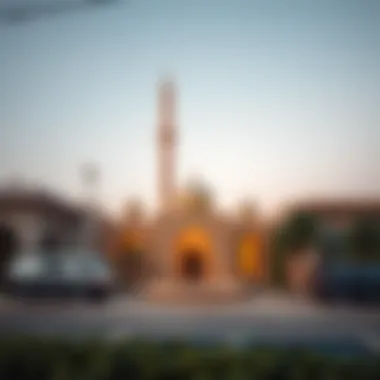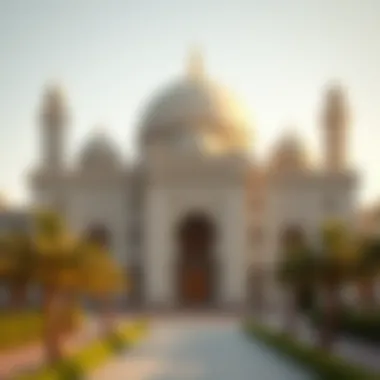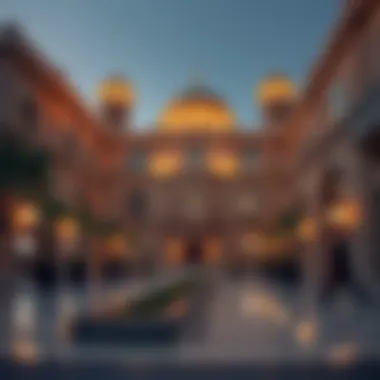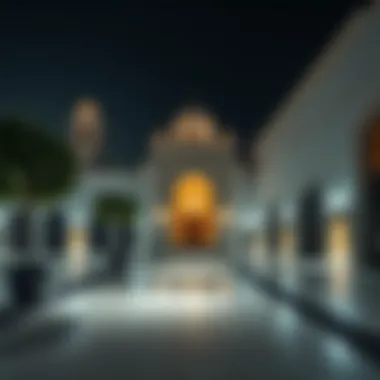Abu Al-Fida Al-Khalidiya: History and Real Estate Insights


Intro
Abu Al-Fida Al-Khalidiya stands as a noteworthy area within the bustling tapestry of Dubai, encapsulating both rich history and promising modernity. This locality has evolved significantly over the years, and understanding its trajectory provides invaluable insights into the broader real estate landscape in Dubai. With each property transaction and every new development project, the influence of Al-Khalidiya becomes evident not just in its architecture or design but in how it shapes community interactions and investment trends.
In today’s fast-paced market, determining where to invest—often feels like navigating a labyrinth. As expatriates and seasoned investors alike look for ripe opportunities in Dubai, gaining an in-depth perspective on regions like Al-Khalidiya is crucial. It’s more than just bricks and mortar; it is about capitalizing on a locality that offers not just housing, but a vibrant community environment. The upcoming sections will take you through key market trends, emerging neighborhoods, and the diverse opportunities that await investors, buyers, and real estate agents in this dynamic area.
Prologue to Abu Al-Fida Al-Khalidiya
The locality of Al-Khalidiya, nestled within the broader context of Abu Al-Fida, holds a pivotal place in both historical and contemporary discussions surrounding urban development in Dubai. Its geographical positioning and cultural significance offer a veritable window into how the region has evolved, reflecting wider trends within the emirate itself. For real estate investors, expatriates, and long-term residents, understanding Abu Al-Fida Al-Khalidiya is crucial not just for grasping the area's past but also for making informed decisions in the bustling property market.
One key aspect of Al-Khalidiya’s importance lies in its historical backdrop, shaped by a tapestry of cultures and eras, including the era of early Islam and later Ottoman influence. This blend has not only given rise to unique architectural expressions but continues to inform the social fabric of the community today.
Additionally, as the modern skyline of Dubai soars, Al-Khalidiya serves as a reminder of the emirate's rich heritage. For community members and investors alike, the locality is both a hub of activity and a sanctuary of history. More than just a place to land, Al-Khalidiya is a canvas illustrating the shifts in economic patterns, lifestyle changes, and investment strategies.
Thus, this section seeks to underscore the significance of Abu Al-Fida Al-Khalidiya, laying the groundwork for a deeper dive into its geographical context and rich historical background that encapsulate its essence.
Geographical Context and Importance
Abu Al-Fida Al-Khalidiya's geographical positioning is strategic within the framework of Dubai's urban sprawl. Located near prominent thoroughfares and essential infrastructures such as the Sheikh Zayed Road, the neighborhood provides seamless connectivity to various parts of the city.
- Accessibility: The area is just a stone's throw away from key districts like Bur Dubai and Al Quoz, which makes it desirable for both residential and commercial purposes.
- Urban Integration: As a location that integrates effortlessly with Dubai's dynamic lifestyle, Al-Khalidiya attracts a mix of occupants, from young professionals to established families seeking the right fit.
This blend of accessibility and vibrant community life makes Abu Al-Fida Al-Khalidiya a focal point for potential property buyers assessing the value and opportunities the locality presents in the rapidly changing market.
Cultural and Historical Background
The cultural and historical roots of Abu Al-Fida Al-Khalidiya run deep, intertwined with narratives that span centuries. Initially inhabited by small communities, the region saw early growth as it became a crucial point of contact for trade routes, facilitating interaction between diverse cultures.
- Historical Significance: The area played a notable role during the early Islamic era, reflecting the broader impact of Islam's expansion on local societies. As Ottoman influence spread, Al-Khalidiya adopted styles and traditions that are reverberating even today in its architectural landscape and community activities.
- Cultural Fusion: This multiplicity of influences has resulted in a melting pot of traditions, further demonstrated in the local cuisine, festivals, and everyday interactions among residents.
Today, the remnants of this colorful past can be felt in the local markets and community networks, sustaining a sense of place for both old-timers and newcomers. Understanding this context allows prospective investors and residents to appreciate the intrinsic value embedded in Abu Al-Fida Al-Khalidiya, setting the stage for broader implications in contemporary real estate and community development.
"To understand a place, one must first understand its roots. Abu Al-Fida Al-Khalidiya is more than just a fantastic investment; it is a living history that shapes the identity of its people."
By tracing this historical significance and cultural depth, we not only appreciate the beauty of Al-Khalidiya but also find key insights into how the area can evolve into the future.
Historical Significance of Abu Al-Fida
The historical relevance of Abu Al-Fida Al-Khalidiya cannot be overstated, as it has played a pivotal role in the unfolding tapestry of Dubai's cultural and economic narrative. Historically, this area has been a melting pot where diverse cultures have intersected, contributing to its transformation into one of Dubai's most sought-after regions. The evolution of this locality mirrors the broader historical developments that have shaped Dubai into a global city.
Role in Early Islamic History
In the early days of Islam, Abu Al-Fida was not merely a geographical location; it was a focal point of learning and residential community life. The region was known for its significant trade routes and proximity to key water bodies which fostered interaction among various tribes. Merchants and scholars frequented this area, establishing it as a bastion of knowledge and commerce. Its strategic location allowed it to serve not only as a trade hub but also as a cultural interchange, fostering the growth of Islamic art and sciences.


The remnants of ancient architectural styles and the layout of the streets offer insights into the lifestyle of the people during that era. The influence of Islamic scholars can still be seen in various facets of life today, such as language and local customs, echoing the past while painting a picture of what once was. The narratives of those early days have a lingering impact today, contributing to the modern identity of the community.
Influence During the Ottoman Period
When the Ottoman Empire extended its reach into this area, Abu Al-Fida experienced a change that would further enrich its heritage. The Ottomans brought with them a wealth of cultural influences, including the establishment of infrastructure that improved trade and communication. They introduced governmental systems that shaped the local administration, positioning Al-Khalidiya as a significant administrative zone.
This period also saw the introduction of various architectural styles that blended traditional Arab designs with Ottoman aesthetics, resulting in distinctive structures that stand today. The intricate details in tile work and the archways of prominent buildings still signify this rich historical layer. Such elements not only enhanced the visual character of the area but also added to its significance in terms of tourism and cultural heritage.
The influence of the Ottoman period on local customs can still be felt today, with unique festivals and culinary traditions that reflect this diverse heritage, making the community more vibrant and appealing to current residents and visitors alike.
Transition to Modern Era
With the advent of the 20th century, Abu Al-Fida began its transition into a modern metropolis. The discovery of oil in the region transformed Dubai and its immediate surroundings, including Al-Khalidiya. The infrastructure was rapidly developed, bringing residential and commercial growth that attracted expatriates and investors. This transition marked a crucial turning point in the area's development, shaping its status within the UAE.
Modern architectural achievements are juxtaposed against older structures, creating a unique skyline that tells an evolving story. Each new building that rises echoes the ambitions of a growing, dynamic community. Today, Abu Al-Fida Al-Khalidiya continues to adapt to the demands of a fast-paced world while holding on to the echoes of its illustrious past. This balancing act between preserving history and embracing modernity offers unique opportunities for exploration and investment.
As one gazes at the architectural marvels juxtaposed with remnants of history, one truly appreciates Abu Al-Fida Al-Khalidiya as a living archive that not only reflects its past but also sets a stage for its future. Ultimately, this dynamic locality remains a crucial element in understanding the broader historical context of Dubai, proving that the past and present are intricately woven together.
The Architectural Landscape of Al-Khalidiya
The architectural landscape of Al-Khalidiya presents a fascinating glimpse into the evolution of urban design amidst Dubai's ever-spiraling growth. This area, known for its blend of traditional and modern elements, offers a unique perspective that reflects both the rich heritage of the region and its ambitious future. Understanding this landscape is crucial for anyone seeking to invest or reside here, as it not only shapes the character of the community but also significantly influences property values and lifestyle experiences.
Traditional vs. Modern Architecture
The architectural fabric of Al-Khalidiya can be characterized by the juxtaposition of traditional Islamic architecture and contemporary designs. Traditional structures often showcase intricate geometric patterns, large courtyards, and high ceilings, embodying a sense of majesty and history. For instance, buildings typically constructed with natural stones and local materials emphasize a connection to the land itself, fostering a sense of identity among its inhabitants.
On the other hand, modern architecture in Al-Khalidiya leans towards sleek lines and minimalist designs, often featuring glass and steel. The shimmering facades of new buildings are a testament to the technological advancements that define Dubai's skyline. A notable example would be the mixed-use developments that encapsulate both residential and commercial spaces, catering to the fast-paced lifestyle of today’s urban dwellers. This combination creates a dynamic that respects the past while embracing innovation, giving Al-Khalidiya a unique architectural identity.
"In Al-Khalidiya, past and future coexist in harmony, mirroring the broader narrative of Dubai itself."
Investors may find that properties exhibiting historical architectural traits often command a premium due to their cultural value. Meanwhile, those opting for modern builds tend to focus on amenities and sustainability features, which appeal to a younger demographic. Understanding these nuances is essential for making informed decisions in the thriving real estate market of Al-Khalidiya.
Prominent Landmarks and Structures
Al-Khalidiya is home to several landmarks that not only shape its skyline but also stand as cultural icons. These structures are more than mere buildings; they tell stories about the community and the dreams of its inhabitants.
- The Khalidiya Palace Resort: This historic hotel stands out with its opulent Arabian architecture and lavish interiors. It offers a glimpse into the region's regal past while providing modern luxury.
- Al-Bashaer Park: A peaceful retreat amid the urban hustle, this park combines manicured gardens with artwork and sculptures reflecting local heritage, making it a gathering place for residents and visitors alike.
- Khalidiya Shopping Mall: A modern commercial hub that attracts shoppers with international brands, eateries, and entertainment options. This structure exemplifies contemporary design while serving as a focal point for community interaction.
Moreover, several mosques in Al-Khalidiya exhibit stunning architectural details, showcasing traditional Islamic craftsmanship. These places of worship not only serve their religious purpose but also act as community centers fostering unity and coexistence.
With each structure telling a tale of its own, the architectural landscape of Al-Khalidiya remains pivotal in marking its identity and influence within the broader context of Dubai. Those involved in real estate must navigate this landscape with an appreciation for both its traditional roots and modern aspirations, as these elements will significantly dictate the area's future development, investment appeal, and community dynamics.
Real Estate Dynamics in Abu Al-Fida Al-Khalidiya
Understanding the real estate dynamics in Abu Al-Fida Al-Khalidiya is crucial not only for current and prospective investors but also for residents and expatriates looking for a place to call home. This vibrant area in Dubai has seen significant changes in the property sector, influenced by a myriad of factors that range from its historical roots to modern-day aspirations. With a comprehensive view of the current market trends, investment opportunities, and challenges that lie ahead, this section aims to illuminate key aspects of real estate in this locality.


Current Market Trends
The market trends in Abu Al-Fida Al-Khalidiya reflect broader developments in Dubai's real estate landscape. As it stands, property values in this area have shown resilience, even amidst regional fluctuations. Recent reports indicate an upward trajectory in rental rates and property sales, prompting investors to take a closer look at this locale. Key factors driving these trends include:
- Infrastructural Development: The expansion of public transport and amenities has recently made Al-Khalidiya more accessible.
- Increased Demand: There's a robust demand for both rental and freehold properties, primarily fueled by the area's strategic location and community appeal.
- Regulatory Framework: The supportive policies enacted by the Dubai government have created a more investor-friendly environment, making it a prime target for real estate investments.
This perfect storm of elements has established Abu Al-Fida Al-Khalidiya as a hotspot, both for local and international buyers.
Investment Opportunities
Investors looking towards Abu Al-Fida Al-Khalidiya can spot a plethora of opportunities that promise both short-term gains and long-term value appreciation. Notable avenues include:
- Residential Property: With growing expat communities, residential complexes are in high demand. Properties like Al Khalidiya Gardens offer modern amenities and attract young professionals.
- Commercial Spaces: The area is seeing an increase in demand for commercial properties. Setting up office spaces or retail in prime locations can lead to substantial returns.
- Mixed-Use Developments: These developments, featuring a blend of residential, commercial, and recreational spaces, are particularly appealing for their potential to create community-focused environments.
By investing thoughtfully, one can leverage the characteristics of Abu Al-Fida Al-Khalidiya to achieve advantageous portfolios.
Challenges in the Real Estate Sector
While prospects abound, the real estate sector in Abu Al-Fida Al-Khalidiya is not devoid of challenges. Investors must consider several potential pitfalls:
- Market Saturation: As more developments spring up, there is a risk of oversupply, which can hurt property values in the long run.
- Regulatory Hurdles: Even though regulations have improved, navigating the legal landscape can still be tricky, particularly for foreign investors.
- Economic Fluctuations: The economy's susceptibility to global events can lead to unpredictability in the real estate market.
In summary, while the pathway to successful investment in Abu Al-Fida Al-Khalidiya is filled with opportunities, it requires one to stay informed and to approach each investment with careful consideration.
Cultural and Community Aspects
The cultural and community elements of Abu Al-Fida Al-Khalidiya are quintessential to understanding its significance within Dubai. These aspects shape the local identity, and foster a sense of belonging among residents while contributing to the area’s attractiveness for investors and expatriates alike.
Community Development Initiatives
In recent years, Abu Al-Fida Al-Khalidiya has witnessed a surge in community development initiatives aimed at enhancing the quality of life for its inhabitants. These initiatives have been pivotal, addressing varied aspects from infrastructure improvements to social services.
Programs such as neighborhood cleanliness campaigns not only beautify the area but also cultivate a spirit of cooperation among residents. Additionally, collaborations with local non-profits focus on education and skill-building, helping to integrate diverse populations, especially expatriates, into the community fabric. For instance, workshops held by the local community centers help residents learn about local customs and traditions, promoting cultural exchange and understanding.
Some of the notable initiatives include:
- Green Spaces and Parks: Development of parks and recreational areas, encouraging outdoor activities and offering families safe spaces to enjoy.
- Local Art Projects: These initiatives engage local artists to create murals and sculptures, making art accessible and integral to community spaces.
- Support Networks: Establishment of groups that provide assistance to newcomers, aiding their transition and fostering friendships.
"Community development is not just about building structures, it's about building relationships that last a lifetime."
Events and Festivals in Al-Khalidiya
Throughout the year, Abu Al-Fida Al-Khalidiya hosts various events and festivals that reflect its rich cultural heritage while also embracing modernity. These gatherings are more than mere entertainment; they are a means to unite locals and expatriates, creating an environment of mutual respect and harmony.


Events like the annual cultural festival highlight the local history and arts, featuring traditional music, dance, and cuisine. These festivities not only serve to instill pride among residents but also attract visitors, boosting local businesses—particularly in the hospitality and retail sectors.
Furthermore, seasonal celebrations like Eid and Diwali see community participation, showcasing a melting pot of traditions. These events encourage people from different walks of life to share their customs and beliefs, which often leads to a profound understanding and appreciation among community members.
To encapsulate the variety of activities in Al-Khalidiya:
- Cultural Festivals: Focus on traditional music, performance arts, and local crafts.
- Seasonal Celebrations: Engage the community in festivities like Eid and Diwali, fostering inclusivity.
- Charity Drives: Events aimed at supporting local charities often attract the collective strength of the community, providing aid to those in need.
In summary, the cultural and community facets of Abu Al-Fida Al-Khalidiya not only preserve its rich heritage but also enhance the attractiveness of the region for potential investors, residents, and visitors. Such dynamics are vital as they bolster social connectivity, ultimately aiding in the area’s economic progress.
Future Prospects for Abu Al-Fida Al-Khalidiya
The future of Abu Al-Fida Al-Khalidiya is a topic that resonates with significant implications for various stakeholders, including investors, residents, and community planners. Given its historical roots and contemporary relevance, understanding its future prospects is crucial in anticipating the evolving dynamics of Dubai's real estate market. The area is positioned not just as a residential hub but also as a potential epicenter for economic growth and sustainability initiatives.
Urban Development Plans
Urban development plans in Abu Al-Fida Al-Khalidiya are shaping the landscape of this vibrant locality. With a strategic focus on enhancing infrastructure, improving living standards, and making the community more attractive to residents and investors alike, these plans are aiming to turn the tide in favor of growth and advancement. Recent proposals include the construction of modern mixed-use complexes that will combine residential, commercial, and recreational spaces, pretty much like a one-stop shop for everything one might need.
- Residential Developments: New residential projects are on the drawing board, promising luxury apartments and affordable housing options. There is a strong push towards adding smart homes equipped with advanced technology, fitting right into the lifestyle of the modern expat and local families.
- Commercial Growth: Businesses are looking towards Al-Khalidiya for their next branch. New office spaces and retail shops are part of the development mix, making it more appealing for small to medium enterprises.
- Public Spaces: Green parks and social hubs are key components of the urban development plan. These spaces are not just about aesthetics; they are designed to promote community interaction and well-being.
This holistic approach to urban development addresses the needs of a growing population while preserving the character of a historically significant area. Thus, one can say that Abu Al-Fida Al-Khalidiya is on an upward trajectory, with developments that are not only forward-looking but also greatly beneficial for its current residents and prospective buyers.
Sustainability and Green Initiatives
In an era where environmental considerations are imperative, Abu Al-Fida Al-Khalidiya is making strides towards embracing sustainability and green initiatives. The local government, alongside private developers, is emphasizing the importance of creating a greener community. This ensures that progress does not come at the cost of the environment.
- Energy-Efficient Buildings: New constructions are being designed with energy efficiency in mind—think solar panels, better insulation, and eco-friendly materials. This not only reduces utility expenses for residents but also helps in promoting a sustainable lifestyle.
- Green Transportation: Plans are in motion to improve public transportation options and incorporate pedestrian-friendly pathways. A stronger emphasis on cycling routes and electric vehicle charging stations is evident, reducing the carbon footprint of daily commutes.
- Community Gardens and Green Spaces: Dedicated areas for community gardens and nature reserves are setup, encouraging residents to connect with nature and cultivate their green thumb.
As these initiatives take root, they not only enhance the quality of life but also attract environmentally-conscious investors and potential residents. The commitment to sustainability positions Abu Al-Fida Al-Khalidiya as a leader in echoing the global call for greener living spaces.
The development plans and green initiatives signal that Abu Al-Fida Al-Khalidiya is poised to be not just a place to live, but a community that values both modern convenience and environmental stewardship.
In closing, the future of Abu Al-Fida Al-Khalidiya looks promising, filled with opportunities that will reshape its identity while staying connected to its historical significance.
The End
As we draw the curtain on this exploration of Abu Al-Fida Al-Khalidiya, it becomes clear that this locale is not just a dot on the map of Dubai. Its rich historical context merges smoothly with its modern significance, making it a focal point for both investors and residents alike.
Abu Al-Fida Al-Khalidiya has transformed remarkably over the years. This shift from a historical ground to a bustling suburb encapsulates the broader narrative of Dubai’s development. For real estate investors, understanding the historical roots of the area is invaluable. The locality’s past serves as a beacon of its potential future, emphasizing the importance of historical context in investment decisions.
Implications for Investors and Residents
The insights gathered about Abu Al-Fida Al-Khalidiya highlight several key takeaways:
- Real Estate Opportunities: Investors are drawn to the region by the appealing market dynamics. The transition from traditional spaces to modern developments creates a range of options that cater to various tastes and budgets.
- Community Engagement: For residents, being part of a historical community offers a sense of belonging. The community initiatives and events that occur throughout the year ensure that residents are not just living in the area but are actively engaged with it.
- Future Growth: Urban development plans indicate a commitment to sustainability and green initiatives, foretelling a future that merges modern living with environmental consciousness. This aspect not only attracts new residents but also ensures long-term investment viability.
"Investing in Abu Al-Fida Al-Khalidiya today is not merely about purchasing property; it's about anchoring oneself in a community rich with history and poised for a robust future."
When weighing the decision to invest or reside in Abu Al-Fida Al-Khalidiya, prospective buyers and residents should consider the area’s unique combination of history, culture, and modernity. As this locality continues to evolve, keeping a finger on the pulse of changes will be crucial for those looking to partake in its journey. Comprehensive understanding of the area's past and present lays the groundwork for making informed decisions in a highly competitive real estate market.
In summary, Abu Al-Fida Al-Khalidiya stands as a testament to the enduring significance of history in shaping the modern landscape. Whether one is investing or simply looking for a place to call home, this region holds promise and potential that should not be overlooked.



